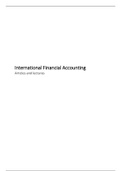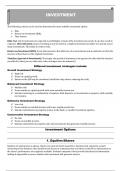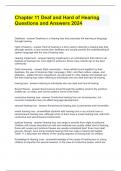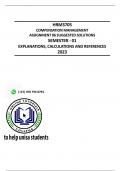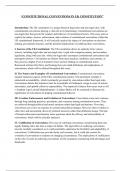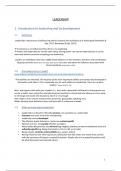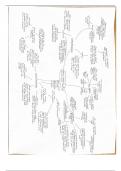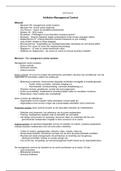Articles and lectures
,Contents
Feltham & Ohlson (1995)...................................................................................................................................................... 3
Lev & Zarowin (1999) ............................................................................................................................................................ 4
Lev & Sougiannis (1996) ....................................................................................................................................................... 5
Dechow & Skinner (2000) ..................................................................................................................................................... 6
Dechow, Ge & Schrand (2010) ............................................................................................................................................. 8
Basu (1997) ............................................................................................................................................................................ 9
Leuz, Nanda & Wysocki (2003) ........................................................................................................................................... 10
Amel-Zadeh, Meeks & Meeks (2016) ................................................................................................................................. 11
Shalev (2009) ....................................................................................................................................................................... 12
Glaum, Landsman & Wyrwa (2018) ................................................................................................................................... 13
Knauer & Wöhrmann (2016) .............................................................................................................................................. 15
Boone, Field, Karpoff & Raheja (2007)............................................................................................................................... 17
Ahern & Dittmar (2012) ...................................................................................................................................................... 18
La Porta, Lopez-de-Silanes & Shleifer (1998)..................................................................................................................... 19
Tirole (2001) ........................................................................................................................................................................ 21
Fee (2015) ............................................................................................................................................................................ 22
Christensen (2016) .............................................................................................................................................................. 23
Zhou, Simnett & Green (2017) ........................................................................................................................................... 24
Kim, Park & Wier (2012) ..................................................................................................................................................... 26
Dhaliwal, Li, Tsang & Yang (2011) ...................................................................................................................................... 27
Di Giuli & Kostovetsky (2014) ............................................................................................................................................. 28
Lectures ............................................................................................................................................................................... 29
2
, Feltham & Ohlson (1995)
Valuation and clean surplus accounting for operating and financial activities
Purpose
This paper models how a firm’s market value relates to accounting data.
Theory
Financial assets = assets and liabilities for which there are relatively perfect markets. Book values and market values
coincide for these assets and liabilities, because we can plausibly conceptualize accounting measurements.
Operating assets = assets that are typically not individually traded in perfect markets. Measurements focus on cash
flows adjusted for accruals, which leads to differences between book values and market values. Examples are
accounts receivables and inventory.
Clean surplus accounting relation = all changes in book value are reported as either income or dividends. The
difference between the cash flows that firms generate each period and the operating earnings is equal to the
accruals on the balance sheet. Going concern firms have four flow variables: operating earnings, interest earnings,
cash flows and dividends. Earnings are produced each period by the net operating assets and the net financial
assets. Operating assets generate operating earnings and transfer the proceeds to financial assets at the end of the
period.
𝑏𝑏𝑏𝑏𝑏𝑏𝑏𝑏 𝑣𝑣𝑎𝑎𝑎𝑎𝑎𝑎𝑎𝑎 (𝑡𝑡) = 𝑏𝑏𝑏𝑏𝑏𝑏𝑏𝑏 𝑣𝑣𝑣𝑣𝑣𝑣𝑣𝑣𝑣𝑣 (𝑡𝑡 − 1) + 𝑒𝑒𝑒𝑒𝑒𝑒𝑒𝑒𝑒𝑒𝑒𝑒𝑒𝑒𝑒𝑒 (𝑡𝑡) − 𝑑𝑑𝑑𝑑𝑑𝑑𝑑𝑑𝑑𝑑𝑑𝑑𝑑𝑑𝑑𝑑𝑑𝑑 (𝑡𝑡)
𝑏𝑏𝑏𝑏𝑏𝑏𝑏𝑏 𝑣𝑣𝑣𝑣𝑣𝑣𝑣𝑣𝑣𝑣 = 𝑜𝑜𝑜𝑜𝑜𝑜𝑜𝑜𝑜𝑜𝑜𝑜𝑜𝑜𝑜𝑜𝑜𝑜 𝑎𝑎𝑎𝑎𝑎𝑎𝑎𝑎𝑎𝑎𝑎𝑎 + 𝑓𝑓𝑓𝑓𝑓𝑓𝑓𝑓𝑓𝑓𝑓𝑓𝑓𝑓𝑓𝑓𝑓𝑓 𝑎𝑎𝑎𝑎𝑎𝑎𝑎𝑎𝑎𝑎𝑎𝑎
𝑓𝑓𝑓𝑓𝑓𝑓𝑓𝑓𝑓𝑓𝑓𝑓𝑓𝑓𝑓𝑓𝑓𝑓 𝑎𝑎𝑎𝑎𝑎𝑎𝑎𝑎𝑎𝑎𝑎𝑎 = 𝑚𝑚𝑚𝑚𝑚𝑚𝑚𝑚𝑚𝑚𝑚𝑚𝑚𝑚𝑚𝑚𝑚𝑚𝑚𝑚 𝑠𝑠𝑠𝑠𝑠𝑠𝑠𝑠𝑠𝑠𝑠𝑠𝑠𝑠𝑠𝑠𝑠𝑠𝑠𝑠 − 𝑑𝑑𝑑𝑑𝑑𝑑𝑑𝑑
𝑒𝑒𝑒𝑒𝑒𝑒𝑒𝑒𝑒𝑒𝑒𝑒𝑒𝑒𝑒𝑒 = 𝑜𝑜𝑜𝑜𝑜𝑜𝑜𝑜𝑜𝑜𝑜𝑜𝑜𝑜𝑜𝑜𝑜𝑜 𝑒𝑒𝑒𝑒𝑒𝑒𝑒𝑒𝑒𝑒𝑒𝑒𝑒𝑒𝑒𝑒 + 𝑖𝑖𝑖𝑖𝑖𝑖𝑖𝑖𝑖𝑖𝑖𝑖𝑖𝑖𝑖𝑖 𝑒𝑒𝑒𝑒𝑒𝑒𝑒𝑒𝑒𝑒𝑒𝑒𝑒𝑒𝑒𝑒
𝑚𝑚𝑚𝑚𝑚𝑚𝑚𝑚𝑚𝑚𝑚𝑚 𝑣𝑣𝑣𝑣𝑣𝑣𝑣𝑣𝑣𝑣 = 𝑏𝑏𝑏𝑏𝑏𝑏𝑏𝑏 𝑣𝑣𝑣𝑣𝑣𝑣𝑣𝑣𝑣𝑣 + 𝑔𝑔𝑔𝑔𝑔𝑔𝑔𝑔𝑔𝑔𝑔𝑔𝑔𝑔𝑔𝑔
𝑔𝑔𝑔𝑔𝑔𝑔𝑔𝑔𝑔𝑔𝑔𝑔𝑔𝑔𝑔𝑔 = 𝑃𝑃𝑃𝑃(𝑒𝑒𝑥𝑥𝑥𝑥𝑥𝑥𝑥𝑥𝑥𝑥𝑥𝑥𝑥𝑥 𝑓𝑓𝑓𝑓𝑓𝑓𝑓𝑓𝑓𝑓𝑓𝑓 𝑎𝑎𝑎𝑎𝑎𝑎𝑎𝑎𝑎𝑎𝑎𝑎𝑎𝑎𝑎𝑎 𝑜𝑜𝑜𝑜𝑜𝑜𝑜𝑜𝑜𝑜𝑜𝑜𝑜𝑜𝑜𝑜𝑔𝑔 𝑒𝑒𝑒𝑒𝑒𝑒𝑒𝑒𝑒𝑒𝑒𝑒𝑒𝑒𝑒𝑒)
𝑃𝑃𝑃𝑃(𝑒𝑒𝑒𝑒𝑒𝑒𝑒𝑒𝑒𝑒𝑒𝑒𝑒𝑒𝑒𝑒 𝑓𝑓𝑓𝑓𝑓𝑓𝑓𝑓𝑓𝑓𝑓𝑓 𝑎𝑎𝑎𝑎𝑎𝑎𝑎𝑎𝑎𝑎𝑎𝑎𝑎𝑎𝑎𝑎 𝑜𝑜𝑜𝑜𝑜𝑜𝑜𝑜𝑜𝑜𝑜𝑜𝑜𝑜𝑜𝑜𝑜𝑜 𝑒𝑒𝑒𝑒𝑒𝑒𝑒𝑒𝑒𝑒𝑒𝑒𝑒𝑒𝑒𝑒) = 𝑟𝑟𝑟𝑟𝑟𝑟𝑟𝑟𝑟𝑟𝑟𝑟𝑟𝑟𝑟𝑟 𝑒𝑒𝑒𝑒𝑒𝑒𝑒𝑒𝑒𝑒𝑒𝑒𝑒𝑒𝑒𝑒 − 𝑅𝑅𝑅𝑅 × 𝑜𝑜𝑜𝑜𝑜𝑜𝑜𝑜𝑜𝑜𝑜𝑜𝑜𝑜 𝑏𝑏𝑏𝑏𝑏𝑏𝑏𝑏 𝑣𝑣𝑣𝑣𝑣𝑣𝑣𝑣𝑣𝑣
𝑅𝑅𝑅𝑅 = 1 + 𝑟𝑟𝑟𝑟𝑟𝑟𝑟𝑟 𝑓𝑓𝑓𝑓𝑓𝑓𝑓𝑓 𝑟𝑟𝑟𝑟𝑟𝑟𝑟𝑟
Since dividends are declared and paid at the end of each period, they directly reduce the book value of the retained
assets. They do, however, not affect the earnings of this period since earnings are generated between t-1 and t. The
dividend policy does not affect how a firm generates future earnings. The market value of a firm is independent of
its dividend policy (in line with Miller and Modigliani).
𝑑𝑑𝑑𝑑𝑑𝑑𝑑𝑑𝑑𝑑𝑑𝑑𝑑𝑑𝑑𝑑 (𝑡𝑡) = 𝑐𝑐𝑐𝑐𝑐𝑐ℎ (𝑡𝑡) + 𝑅𝑅𝑅𝑅 × 𝑓𝑓𝑓𝑓𝑓𝑓𝑓𝑓𝑓𝑓𝑓𝑓𝑓𝑓𝑓𝑓𝑓𝑓 𝑎𝑎𝑎𝑎𝑎𝑎𝑎𝑎𝑎𝑎𝑎𝑎 (𝑡𝑡 − 1) − 𝑓𝑓𝑓𝑓𝑓𝑓𝑓𝑓𝑓𝑓𝑓𝑓𝑓𝑓𝑓𝑓𝑓𝑓 𝑎𝑎𝑎𝑎𝑎𝑎𝑎𝑎𝑎𝑎𝑎𝑎 (𝑡𝑡)
𝑑𝑑𝑑𝑑𝑑𝑑𝑑𝑑𝑑𝑑𝑑𝑑𝑑𝑑𝑑𝑑 (𝑡𝑡 + 1) = 𝑓𝑓𝑓𝑓𝑓𝑓𝑓𝑓𝑓𝑓𝑓𝑓𝑓𝑓𝑓𝑓𝑓𝑓 𝑎𝑎𝑎𝑎𝑎𝑎𝑎𝑎𝑎𝑎𝑎𝑎 (𝑡𝑡) + 𝑓𝑓𝑓𝑓𝑓𝑓𝑓𝑓𝑓𝑓𝑓𝑓 𝑐𝑐𝑐𝑐𝑐𝑐ℎ 𝑓𝑓𝑓𝑓𝑓𝑓𝑓𝑓𝑓𝑓 𝑓𝑓𝑓𝑓𝑓𝑓𝑓𝑓 𝑜𝑜𝑜𝑜𝑜𝑜𝑜𝑜𝑜𝑜𝑜𝑜𝑜𝑜𝑜𝑜𝑜𝑜𝑜𝑜
Key assumptions in the model are (in line with Miller and Modigliani):
• Perfect market = no buyer or seller has enough securities to have an appreciable impact with his
transactions on the then ruling price.
• Rational behavior = investors always prefer more wealth and do not care whether it takes the form of cash
payments or an increase in the market value of their securities.
Unbiased accounting = the market value is on average equal to the book value. The market value is based on the
book value and the earnings.
Conservative accounting = the market value is on average higher than the book value. In determining the market
value, an adjustment is made for the undervaluation of assets. This makes it important to report separately about
financial and operating assets.
Summary
The market value of a company is determined by its opening book value and its abnormal earnings. The abnormal
earnings are determined by the earnings and book value of the firm and by the risk free rate in the market. The
market value is thus related to accounting data.
3

